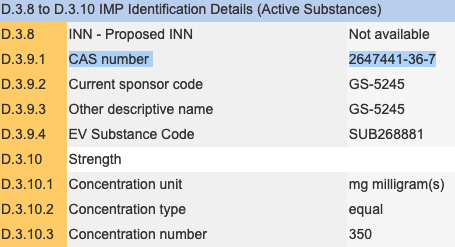Confirmed correct on April 4, 2023 by a press release by Gilead to Reuters and in an April 28, 2023 preprint on bioRxiv.
How I figured out the structure of GS-5245 in December 2022 & some background into how I got into this sort of detective work.
GS-5245 is an oral RNA-dependent RNA polymerase (RdRp) inhibitor developed by Gilead Sciences (GILD 0.00%↑) with broad-spectrum antiviral activity. It is currently in phase 3 trials for the outpatient treatment of COVID-19 (NCT05715528, NCT05603143). RdRp is essential for replication of RNA viruses like SARS-CoV-2, Ebola virus, and and RSV.
GS-5245 is often referred to by Gilead as an “oral remdesivir.” However, this is somewhat of a misnomer. GS-5245 is actually an oral version of GS-441524, the parent nucleoside of remdesivir. The reason why this is important is because, while remdesivir contains a phosphate moiety, GS-441524 does not.
I make this distinction because my foray into small molecule detective work began with GS-5245 and was spurred by my advocacy work with GS-441524, which you can read about here, here, and here.
From my GS-441524 work, I learned how to find information using resources typically overlooked by academic researchers. I also learned how to connect dots between available data to yield insights that did not require performing additional experiments. This was very helpful, considering I had little-to-no access to a lab during the pandemic. The full backstory of my GS-441524 advocacy work can be found here.
The big break : NIH Filovirus Workshop
Backstory aside—the first major break in GS-5245 case came on March 9, 2022, when Gilead presented data on this compound at the NIH Filovirus Workshop. Prior to this, the company had referred to GS-5245 as “oral remdesivir” or “novel nucleoside for COVID-19 treatment.” Semantics are important here: remdesivir is a nucleotide analogue (contains phosphate), while GS-441524 is a nucleoside analogue (does not contain phosphate). So, at the time, it wasn’t clear whether GS-5245 was a phosphate prodrug or a GS-441524 prodrug.
All this confusion was put to rest when they showed the schematic of how GS-5245 works. Without a doubt, GS-5245 is a GS-441524 prodrug.
The question then became: what kind of GS-441524 prodrug is it? One key reason why Gilead was reluctant to advance GS-441524 as an oral drug was its low oral bioavailability. In nucleoside analogue field, a tried-and-true way around this problem is esterification.

But what kind and how many esters does GS-5245 possess (1, 2, or 3)? Was it a valine ester (à la ganciclovir/valgancyclovir) or an isobutyric ester (à la molnupiravir)? These were some of the outstanding questions.
To make matters more interesting, the Wuhan Institute of Virology had partnered with Vigonvita Life Sciences/Junshi Biosciences to develop “VV116 (JT001)”: a deuterated tri-isobutyric ester prodrug of GS-441524. Was Gilead’s GS-5245 also a tri-isobutyric ester of GS-441524? They were certainly publishing high profile papers on a tri-isobutyric ester prodrug during this time. And their GS-441524 prodrug patent included quite a lot of in vivo efficacy data on said tri-isobutyric ester prodrug.
Yet Gilead stated that they had no plans to pursue the tri-ester prodrug.
So…red herring?
This taught me an important lesson: the use of decoy compounds. Just because a compound is backed by significant in vivo data in a patent or elsewhere, this DOES NOT mean that it will be the clinical compound. Go figure.
Sealing the deal
So how did I figure out the actual structure of GS-5245? EU Clinical Trials Register!
Searching for GS-5245 returns the registered trials. But a key feature present in the EU trials registry but not clinicaltrials.gov is that it includes the very helpful CAS number!
The CAS number is a code assigned by Chemical Abstract Services assigned to every public chemical structure. You can use the CAS number to lookup the associated structure. And doing so returns…
…the structure of GS-5245! A 5’ mono-isobutyric ester prodrug. And we also now know that the international nonproprietary name (aka, the generic name) is obeldesivir!
Super cool. I’ve been following this story for a long time, so confirming that GS-5245 is a GS-441524 was one of my highlights of 2022 (no joke). Hope you found this enjoyable! Future posts will be more succinct but will walk through my thought process in greater depth than on Twitter (@victoriacyanide). So keep your eyes peeled!
Have a compound that you want me look into? Suggest a compound here.








